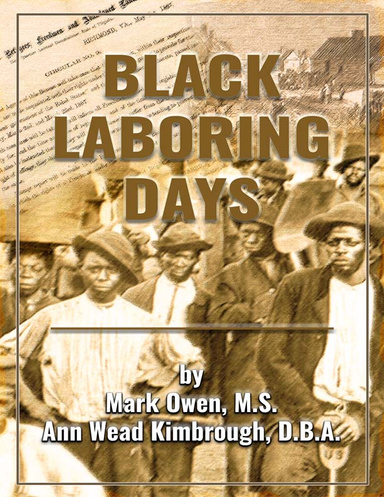It’s’ Labor Day. The “celebration” is a U.S. holiday and has been dubbed the unofficial closing of summer. There are many layers to the meaning of Labor Day for Black folk. Here is an excerpt from the ebook, “Black Laboring Days,” Copyright © 2021 by Ann Wead Kimbrough, Mark Owen
Chapter Four
Labor Day and Black Codes, Black Laws

Most of us regard the Labor Day weekend each September
as the official end of summer. Yet, Labor Day had different
meanings for the once enslaved African Americans who
worked for no wages on lucrative agricultural plantations.
Even after the Union defeated the Confederate states in the
Civil War, those freed by the federal statute continued to
endure harsh conditions during the Reconstruction period.
Those conditions were imposed upon African Americans by
the Southern states’ Black Codes (read in the next section of
this blog) while U.S. labor unions were waging efforts for
the federal government to enact a national holiday in honor
of other laborers.
The federal law creating Labor Day was born to
recognize the employed men, women, and children. During
the Industrial Revolution in late 1800, several atrocities were
reported about the working conditions for the impoverished
and new migrants whose average workdays were 12 hours
and children as young as five were included. (Labor Day
2021: Facts, Meaning & Founding – HISTORY). On Sept. 5,
1882, the first Labor Day parade took place in New York
City. See below.

Black Codes, Black Laws

Meanwhile, African Americans were suffering as
laborers during the same late 19th century period. African
Americans’ treatment in the Industrial Revolution era was
deemed as carryover treatment from the days of mass
enslavement. Post-slavery and during the Reconstruction,
every Southern state’s legislature enacted Black Codes to
“protect their investments” (Project MUSE – Blue Laws and
Black Codes (jhu.edu) and to build infrastructure. In
Virginia, prison labor on the chain gang was primarily
comprised mainly of African Americans who were deemed
vagrants and guilty of other crimes under the state’s Black
Codes. The chain gang members were not compensated, and
their purpose was to build roads “to bring Virginia into the
automobile age.” (Project MUSE – Blue Laws and Black
Codes (jhu.edu)
Black codes required freed African Americans to sign
yearly labor contracts. If they refused to sign the agreements,
the laborer risked being arrested, fined, and forced to join the
chain gang and not receive any wages for their toils. (
https://www.history.com/topics/black-history/black-codes)
https://nomoreslaveryyay.weebly.com/rights-and-vagrancylaws.html
According to numerous historical documents, Congress
passed legislation to repeal all Black Codes, yet the Southern
States continued with its practices.
(https://nomoreslaveryyay.weebly.com/rights-and-vagrancylaws.html)
There was an overlap of Black Codes in non-Southern states.
Known as the Black Laws, the restrictions were enacted in
conditions that included Ohio in 1803. Author Stephen
Middleton, (The Black Laws: Race and the Legal Process in
Early Ohio · Ohio University Press / Swallow Press
(ohioswallow.com) explains Black slaves and free African
Americans found refuge in Ohio. Yet, new laws prohibited
many movements and imposed restrictions that were
eventually overturned in 1886.
Real Labor Days
The real labor days began in the 17th century in the United
States. Enslaved ancestors from the Trans-Atlantic Slave
Trade were often sold and repurchased again at marketplaces
like this one on Whitehall Street in Atlanta, Georgia.
Civil war photographs, 1861-1865, Library of Congress,
Prints and Photographs Division
The involuntary work performed by slaves has been
documented in multiple media formats. However, leading
scholars on the topic of African Americans’ slave history,
“Clearly, dominant narratives at historic plantation sites have
long been maintained by a white elite class at the expense of
the enslaved and African American history in general. There
is evidence of inclusion of the enslaved at the plantation
museums; however, this movement is slow and
evolutionary—not revolutionary.” (SEGEOGLOGO.eps
(d1wqtxts1xzle7.cloudfront.net)
The enslaved life was anything but glamorous. Southern
plantations were booming in commerce. Due to demands for
cotton, tobacco, rice, and all agricultural products, the wealth
of its owners increased the intensity to grow the slave
population. Dark-skinned people, including Spence Johnson,
the once free member of the Choctaw Nation, were placed in
involuntary servitude. He and his family lived in the Indian
Territory in 1850 when his mother and Johnson were sold at
a Louisiana slave auction. They were not brought to the
United States during the Trans-Atlantic Slave Trade, yet
were stolen and sold to perform free labor on giant
plantations:
As if laborious tasks were not enough to complete, slaves
were the victims of horrific crimes against their bodies.
Sometimes the chopping off of legs and arms and even
women’s breasts were designed to keep slaves from fleeing
their plantations. In the case of the phenomenal inventor and
scholar George Washington Carver, he was castrated as a
child by his master. His enslaver wanted to ensure the
African American slave would not be intimate with the
White man’s daughter.
(George Washington Carver Was Not
Gay, But Castrated (Updated 2021) – MICHEAUX
PUBLISHING (wordpress.com

September Laboring Day
Ebook | By Ann Wead Kimbrough, Mark S. Owen
ISBN: 9781716435287

